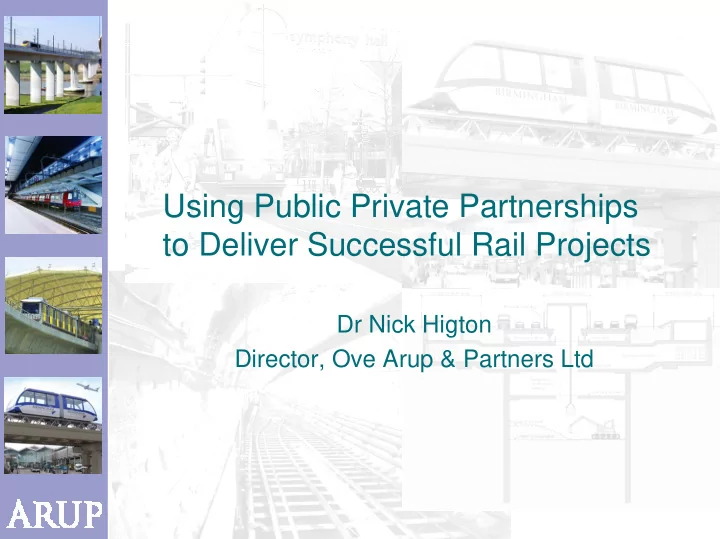

Using Public Private Partnerships to Deliver Successful Rail Projects Dr Nick Higton Director, Ove Arup & Partners Ltd
Topics • Why consider a PPP solution? • Public & private sector roles & responsibilities • Transferring responsibility to the private sector • Contract options • Performance regimes • Private sector view of risk & reward • Relationship building • Learning points for future PPPs
Why consider a PPP solution? • To satisfy a social or economic need • To reduce impact on Government finance • To increase predictability of financial and physical outcomes • To increase value for money • To transfer risk to the private sector
Key client-side issue for PPP delivery • Client is buying a service, not assets • But with a legitimate interest in the assets for: • Service extensions & expansions • Supplier breach or default • Transfer upon contract completion • PPPs require clients to give private sector suppliers the space to be innovative in how the service is delivered
Responsibility transfer to the private sector Usual public sector responsibilities, in PPPs: • Performance specification • External technical interface specifications • Planning, approvals and consents • Revenue risk • Technical specifications (high level) • Preliminary design • Remunerating the PPP supplier
Responsibility transfer to the private sector Usual private sector responsibilities, in PPPs: • Capital finance • Detailed design • Build – construction / installation • Operate – infrastructure and / or trains • Maintain • Transfer
Contract Options • Depends on client's attitude to involvement in the project, and comfort with transferring responsibility and risk • For example: • Lump sum package contracting – greatest client control • Design & build – client control over scheme issues • PPP – client control over performance specification • PPP should achieve greatest risk transfer • To be ‘off balance sheet’ maintenance and / or operation must be transferred to the private sector
Client clarity – defining what is really needed • Efficient public transport service • Providing employment? • Political considerations? • Fare levels vs. public subsidy? • When is it needed? And can the client avoid changing his mind?
Railway PPPs – Performance specification features • Availability – providing the service • Stations: locations, opening hours, passenger through- put • Trains: journey time, frequency, passenger capacity • System: reliability, safety, degraded mode operation • Ambience – quality of the journey experience • Quality of finishes, seats / standing ratios, lifts & escalators provision, customer information, fare collection • Capability – making provision for the future • Systems architecture, external interfaces • Transfer – securing a trouble-free hand-back • Return condition, maintenance manuals & records, final years issues
Private sector view of risk & reward • Uncertain clients are a big opportunity – and risk • Prefers competent clients • Provides capital & expects a fair return on its investment • Provides technical expertise & wants to use it • Minimises costs of meeting specification • Conservative – will over-compensate for risk, particularly where it is not in full control • Will only deliver what it is paid for
Supporting the client – supplier relationship • Clear & fair contract • Adequate space within which the supplier can operate • Limited prescription • Resist fragmenting service delivery • Knowledgeable and experienced staff on both sides • Partnering and alliancing • Incentivisation – proportionate risk and reward • Incentivise key outputs • Test for ‘perverse incentives’ • Protect client position in secondary market
Learning points for future rail PPPs - clients • Client ownership of strategy & policy • Client acceptance of the transfer of responsibility, risk and decision making • Client’s unavoidable legal obligations • Client retains responsibility for interfaces between contracts • Client is ‘operator of last resort’ • Client must remain an informed buyer • Client will probably have to remunerate capital costs, & part of operating costs • Clients often under estimate costs & over estimate revenues
Learning points for future rail PPPs - suppliers • Private sector suppliers bring funding, off public sector balance sheet providing they take adequate operating risk • Suppliers are extremely focussed on what has to be achieved • Suppliers dislike taking revenue risk • Suppliers dislike taking planning risk • Suppliers dislike, and will take advantage of, an uncertain client • In negotiation, suppliers will seek to over- emphasise risks, and clients to play them down
Conclusions • Rail PPPs can be very successful for both public and private sectors, if skilfully applied • Clients must clearly understand and communicate their objectives to suppliers, then stand back • However, clients should remain informed and able to exercise some key controls • Private sector participation is good, if its commercial remit is mobilised in the client’s interest • Contracts should be clear, fair and stable • Successful PPPs require role clarity, consistency, and contractual predictability • Attention to role clarity issues, and specification details, makes for successful PPPs
Using Public Private Partnerships to Deliver Successful Rail Projects Dr Nick Higton Director, Ove Arup & Partners Ltd
Recommend
More recommend